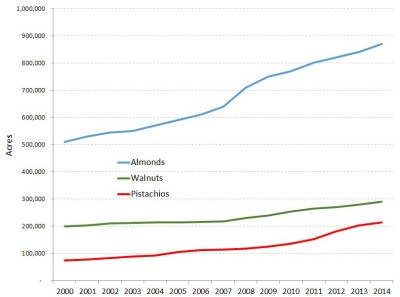By Peter Gleick, President
California is a wonderful place to grow food. The climate is highly favorable; soils are some of the best in the world, it is located well to serve global distribution markets with major ports and other transportation infrastructure; and normally, some regions are relatively well-watered.
Normally.
In a climate where rainfall is so variable from one year to the next, it makes little sense to talk about what is “normal” but California farmers know to expect that some years will very dry and that sometimes there will be a string of dry years back-to-back.
Media coverage of the current California drought has included various attempts to describe where California’s water goes, from flushing toilets to growing crops to bottled water to supporting fisheries. One high-profile target in the media has been California’s major nut crop – almonds – which has been described (and often vilified) for its water use. Many stories have latched on to an estimate that each almond kernel (nut) requires around a gallon of water to produce.
This Pacific Institute analysis addresses two questions:
- Is this number correct?
- And if so, what does it really mean?
The Numbers
First, how much water really goes to growing California almonds? The amount of water required to grow any crop varies with the climate, soil, irrigation method, and other factors. To compute the amount of water required, we need to know the acreage of almonds, the amount of water applied per acre, the yield of almonds (measured as the final shelled product) per acre, and the number of almonds per pound. For California, here are the basic numbers:
Acreage of Almonds: In 2014, there were approximately 870,000 acres of almond orchards (bearing) throughout the state, up from around 510,000 acres in 2000 and 770,000 acres in 2010 (USDA 2015). Figure 1 shows the massive expansion of almond, pistachio, and walnut acreage between 2000 and 2014. Total crop acreage in California during this period remained relatively constant due to reductions in plantings of field crops.

Water Use per Acre of Almonds: All crops require water and the total water requirement varies throughout the growing season as a function of temperature and other climatic factors, the characteristics of the plants themselves, soil conditions, irrigation methods and efficiencies, and more. For almonds, the crop water requirement is roughly between 40 and 55 inches per year – more in the hotter southern California region; less in the cooler northern California areas. Average water use is approximately 44- 48 inches per year (UC Davis; DWR). Certain advanced irrigation methods, such as regulated deficit irrigation, can cut this by as much as 30% or more, but these are not widely applied yet and such methods also may affect crop yields and quality.
Almond Yield: What does an acre of almond trees produce annually? In California, between 2010 and 2014, almond production averaged 2,325 pounds per acre according to the USDA National Agricultural Statistics Service.
Combining these data shows that a pound of almonds requires between 520 to 560 gallons of water:
Nuts per Tree or Weight per Nut: The US Department of Agriculture reports that in California the average number of almonds per tree is around 6,700, and the average weight of each almond kernel (the part we eat) is around 1.4 grams per nut.
Total Water Use for Almonds: Combining these numbers we estimate that total applied water use for almonds in California was around 3.1 million acre-feet in 2010. That number was almost certainly higher in 2014, but no final data for last year are available yet.
Water per Almond: When combined with the yield information above, almonds required between 1.6 and 1.7 gallons of water per nut, somewhat higher than the 1 gallon per nut commonly reported elsewhere, but of a comparable magnitude.
But What Do the Numbers Mean?
Is this a lot of water to produce an almond or a little? How much water does it take to grow a grape, watermelon, head of lettuce, or cow? Is such a measure useful?
It is too simplistic to look at the amount of water required to produce a specific item and pass judgment, without understanding global markets, technology, climate, and more. Farmers make choices of what crops to grow based on many factors and signals, from market prices for commodities, to the quality of their soil, to water availability, to the kinds of equipment in their barns. There is a strong market for almonds and they produce good returns to farmers. In addition, water-use efficiency in almond orchards – that is the amount of water required to produce a particular good or service – has been improving over time as better irrigation technologies and methods have been applied. This is a good thing – it permits growers to produce more food and income per unit water.
But it is also true that the massive expansion of California orchards – especially almonds – imposes some real negative costs to communities, leads to the loss of local groundwater where some wells are drying up, and reduces the flexibility of the State to deal with shortages when permanent crops replace crops that can be temporarily fallowed in bad years. Local opposition to new orchards is growing rapidly and a backlash is likely. A spotlight is being shined on the role of corporate investors in the agricultural sector.
During a severe drought, when there is not enough water to satisfy all demands, tough questions arise: What should California be growing and with what irrigation methods? Should growers with low-priority water rights and uncertain water availability in drought years be able to plant new orchards that require permanent water without bearing all of the risks of those decisions? Should new orchards watered with groundwater be prohibited in regions of severe groundwater overdraft? Should there be a change in water-rights allocations in favor of (or away from) permanent crops? Should specific irrigation methods be required for certain crops or soil types? Should all decisions about water allocations in agriculture be left to economic markets rather than allocated by historical rights, as some economists argue? What role, if any, should public agencies play in influencing or regulating water-use patterns in agriculture? Should the State Water Resources Control Board more explicitly define “reasonable and beneficial use?”
In the end, if the gap between water supply and water demand continues to grow, California will have to make fundamental changes to agriculture in a way that ensures both a strong agricultural sector and a healthy environment. The conversation about how to do this must include a discussion of incentives, disincentives, regulatory and market conditions, and impacts to all affected parties. In the end, it is about far more than just almonds.
Pacific Institute Insights is the staff blog of the Pacific Institute, one of the world’s leading nonprofit research groups on sustainable and equitable management of natural resources. For more about what we do, click here. The views and opinions expressed in these blogs are those of the authors and do not necessarily reflect an official policy or position of the Pacific Institute.
This blog was originally published in ScienceBlogs. You may find the original article here.


